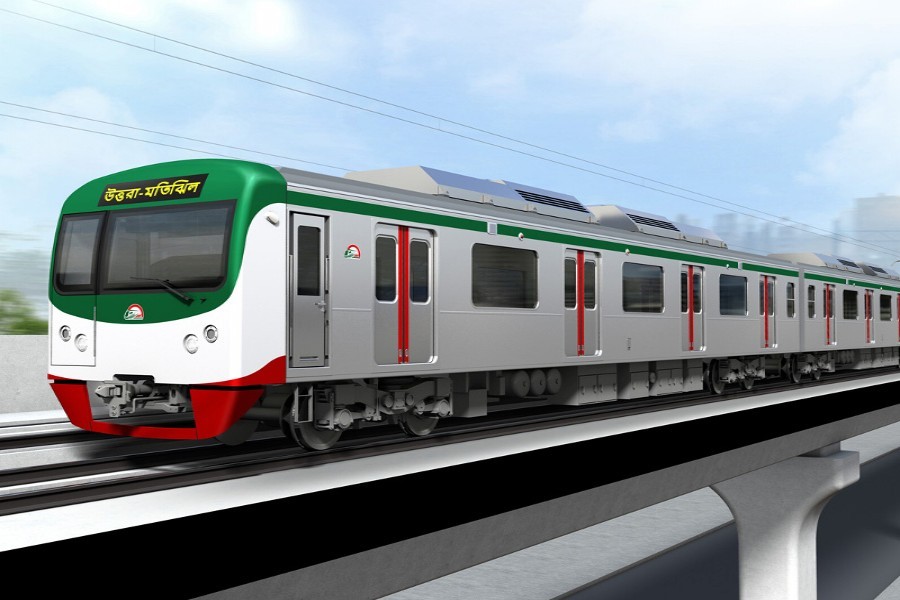
Published :
Updated :

Now that a chart of fares for travelling the 20.10-kilometre Uttara-Motijheel metro rail route, and 14 others in between, has been published in the media, commuters on that route have started feeling upbeat. There are reasons to feel so. Although several dates for the inauguration of the elevated metro rail service have been announced several times and postponedlater, its final opening became veritably a mirage of sorts. But technical and other work keep going fast. Amid these bouts of progress, the future Dhaka metro commuters do not want to see a day wasted away. The commuters willing to use the Uttara-Motijheel route going through several areas like Mirpur, Kazipara, Agargaon, Farmgate, Karwan Bazar, Shahbagh, Dhaka University, Secretariat and Motijheel are now impatient to see the metro service open. According to Dhaka Transport Coordination Authority (DTCA),the Uttara-Agargaon route is scheduled to be in operation in December this year. The Agargaon-Motijheel service is set to be in place from December, 2023.
Meanwhile, the DTCA has fixed the fare chart for the Uttara-Motijheel metro route. Commuters travelling through stations from the beginning to end in both directions will have to pay the smallest amount of fare of Tk 20. As the train speeds forward, the fare will continue to increase. The amount will go upward in an order starting with Tk 30 for Pallabi, the first station out of the stoppages in the Uttara area. It is followed by Tk 40, Tk 50, Tk 60, Tk 70, Tk 80, Tk 90 for 14 stations, ending with Tk 100 for the final destinations: Motijheel (to be extended to Kamalapur) and Uttara (Centre). To the general people, the fares may seem too high compared to buses. But when the travel time is taken into consideration compared to that of the buses, the 20.10km metro journey may seem to be highly sought-after. While the normal public buses require three to 3-and-half hours on travel between Uttara and Motijheel/Kamalapur, the metro rail is set to take a little over 40 minutes to cover the same distance. The maximum speed of the train is projected to be 100km/h, the average speed being 30km/h. No matter whichever transport mode is in operation, the very fact of taking only 40 minutes in covering the Uttara-Motijheel, later also Kamalapur, distance was incredible even a decade ago. The elevated metro rail is set to make this veritable pipedream turn into a reality. Apart from benefiting daily passengers like office-goers of all grades, students, teachers, and medical treatment-seekers to businesspeople and others, the speedy train is expected to have a positive impact on the Dhaka-based trade and commerce. In business operations these days, time is a great factor. Thus businesses based on river transports in Old Dhaka or surface trains using Kamalapur station could be eased greatly.
The metro rail can enable the businesspersons and entrepreneurs to reach their workplaces at different city points on time. In short, the speed of the metro rail is set to bring about a radical change in multifarious ways in Dhaka's urban life. As is normal, the metro service can wean the people from the 'deluxe' A/C buses. They charge Taka 100-110 for travels on the Uttara-Motijheel route. The fare of the non-A/C buses running on the same route ranges between Taka 50 and Tk 60. As mentioned earlier, the travel time on both the bus routes is between 3 and 4 hours. The metro rail will have the capacity to carry 60,000 passengers an hour from Uttara to Motijheel.
The publication of the metro rail fare chart has, undoubtedly, added to the city commuters' hope to see astate-of-the-artcommunicationmode. Like the underground subway, the overhead railway service, too, is radically different from the traditional surface railway. The one common thing that features both the underground and elevated commuting services is their high speed. The travels are unhindered. Moreover, the travel time of these alternative railway services remain the same unless technical malfunctions crop up at a stoppage or midway. In reality, these complications occur rarely.
Turning to the Bangladesh case, even in the 1970s and the 1980s, these trains remained lodged in the dreams of the railway lovers. With the mention of subways, it is London 'tubes' and Washington's underground railway, the two busiest metro communication services in the world, which would flash across the fans' mind. The Kolkata Patal Rail (subway) and Delhi metro are two of the oldest underground rails in South Asia. On the other hand, the elevated rail is fast becoming outmoded in many developed cities around the world. In the US, only the cities of New York and Chicago have elevated trains in service, called the remnants of the glorious days of this mode of railway.
During the construction of Dhaka's elevated metro rail, the mass rapid transport authorities had to pass through lots of adversities. They were mostly related to clearing the railway routes of scores of underground utility service lines. A few cumbersome problems still haunt the Mass Rapid Transit-6 authorities. One of them is a few stations' narrowstairways connecting the footpaths below. Apart from the alleged impractical design of the main stations, the stairs have been brought down to the already squeezed walkways in such a way that jostling between the footpath users and metro passengers is feared to remain a continued nuisance. This needs to be corrected at the earliest.
shihabskr@ymail.com


 For all latest news, follow The Financial Express Google News channel.
For all latest news, follow The Financial Express Google News channel.